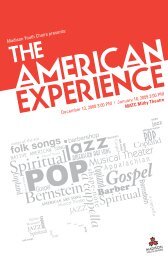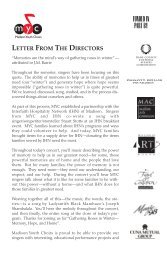Songs for a Small Planet (May 2009) - Madison Youth Choirs
Songs for a Small Planet (May 2009) - Madison Youth Choirs
Songs for a Small Planet (May 2009) - Madison Youth Choirs
Create successful ePaper yourself
Turn your PDF publications into a flip-book with our unique Google optimized e-Paper software.
Glasgow. The origins of the song are unclear: one popular theory attributes the song to<br />
a Jacobite highlander captured by the English in 1745 and refers to the English torture<br />
of choosing one to live (“the high road”) and one to die (“the low road”). Others theorize<br />
that the song is sung by lover of a captured Scottish rebel set to be executed; the<br />
heads of those executed were set on pikes on the main road between London and Glasgow<br />
(“the high road”) while the relatives of those killed returned home from the execution<br />
on the lesser roads (“the low road”).<br />
Byker Hill<br />
Traditional Scottish Song<br />
Arranged by Mitchell Sandler<br />
Scottish coal miners endured harsh working and living conditions. This song refers to two<br />
especially successful Scottish mines—Byker Hill and Walker Shore. In the song, the miners<br />
(collier lads) unwind after a day of unenviable conditions by drinking (bumble—a<br />
mixture of gin and beer) and becoming increasingly absurd (talk of hitting a pig with a<br />
shovel and dancing a jig is clearly not to be taken literally). This arrangement is based<br />
on the version by the San Francisco-based men’s choir Chanticleer.<br />
RAGAZZI AND HOLST<br />
Michael Ross, Randal Swiggum, Margaret Jenks, conductors<br />
L’homme Armé<br />
Missa L’homme armé: Kyrie<br />
Anonymous, c. 15 th century<br />
Johannes Ockeghem (c.1420-1497)<br />
Like many of his contemporaries, Ockeghem took up the challenge of setting a popular<br />
tune of the day, L’homme armé (The armed man) within a mass. His Missa L’homme<br />
armé is a cantus firmus mass; it uses the popular tune (which you’ll hear sung first in<br />
French) and places it as a fixed melody (cantus firmus) in the tenor line, around which he<br />
composes free polyphony. Today you’ll hear these two pieces sung by all male voices—<br />
a per<strong>for</strong>mance practice dating to the 15 th century.<br />
RAGAZZI<br />
Michael Ross, conductor<br />
Ave Maria Franz Biebl (1906-2001)<br />
Biebls’ work is a standard of 20 th century choral music. He weaves Gregorian chant<br />
melodies in between homophonic sections to create a link to the musical past.




